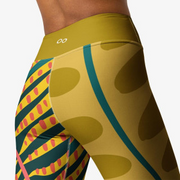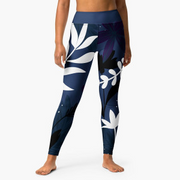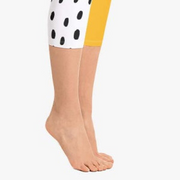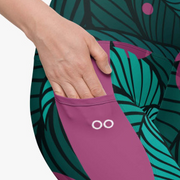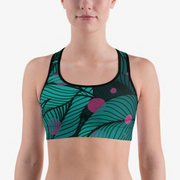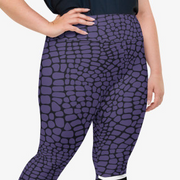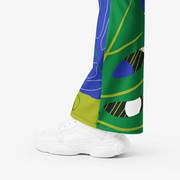Welcome, leggings lovers and fashionistas, to a jaw-dropping journey through the realm of fast fashion! As the heartbeat of the global fashion industry, fast fashion continues to dazzle us with its trends, patterns, and eye-catching styles. But beneath the glitter and glamour lies a tale of astonishing statistics that reveal the true cost of our fashion choices.
It’s estimated that more than two tonnes of clothing are bought each minute in the UK, more than any other country in Europe. That amount produces nearly 50 tonnes of carbon emissions, the same as driving 162,000 miles in a car.
Join us as we delve into the world of fast fashion, exploring its impact on our planet, our communities, and our closets. Brace yourselves for a rollercoaster ride of facts and figures that will leave you stunned and inspired to make more informed fashion choices.
What is Fast Fashion?
Fast fashion brands are ones that produce large quantities of apparel each year. Fast fashion firms have 52 micro-seasons instead of releasing new styles twice a year in the traditional spring/summer and winter/fall seasons. Customers now have constant access to reasonably priced, stylish apparel that is new.
We value our garments less because we pay less for them. Wearing something only a few times before throwing it away is a common occurrence. Because we can purchase new garments online with only a few clicks and at a lower cost than ever before, we are becoming less attached to the clothing we purchase.
As we begin a new year, it is instructive to reflect on the revelations surrounding fast fashion in the previous year. These revelations highlight the continued prevalence of unethical business practices within this industry, which appears unwilling to break free from its unsustainable business model that continues to exploit textile workers.
20 Statistics About Fast Fashion
Below is a list of 20 eye opening statistics about the fast fashion industry from the Materials Market Report, Gitnux, Earth.org, and ecothes:
- 1% of prominent fashion brands disclose how many of the workers in their supply chain get paid a living wage
- Only 25% of textile and garment workers received their full wages after the Türkiye earthquake
- A survey revealed that UK consumers consider H&M, Nike, Primark, M&S, and Amazon the most sustainable retailers
- 9% of fashion brands do not disclose a commitment to cut the number of items they create
- 76% of the items sent to fast fashion take-back schemes were destroyed, left in warehouses, or shipped to African countries
- Polyester accounted for 54% of the global fibre market
- The Apparel Industry’s Global Emissions Will Increase by 50% by 2030 (World Bank).
- Fashion could become responsible for a quarter of the world's carbon budget by 2050 (WWF)
- Just buying one more used item instead of brand new this year could save 5.7 billion tonnes of CO2 emissions (Loop Generation).
- If half the items bought in the UK were second hand it would save 12.5 BILLION kilograms of CO2 created by making new clothes from entering the atmosphere. This is the equivalent of 261,000 flights from London Heathrow to Athens or a plane flying around the world more than 17,000 times. (Oxfam).
- The global fast-fashion market is projected to reach $43.4 billion by 2029.
- The fast fashion industry could use 26% of the planet’s carbon budget by 2050.
- Every second, the equivalent of one garbage truck of textiles is landfilled or burned.
- 20% of industrial water pollution globally is attributable to the dyeing and treatment of textiles.
- Fast fashion brands are producing twice the amount of clothes today than in 2000
- Nearly 10% of microplastics dispersed in the ocean each year come from textiles
- It takes 20,000 litres of water to produce one kilogram of cotton
- Only 4% of consumers in the UK say they “only buy from sustainable clothing brands”
- 80% of garment workers are women and they are routinely paid less than their male coworkers
- 93% of brands don’t pay garment workers a living wage
The Rise of Fast Fashion
In recent years, fast fashion brands have dominated the apparel industry, churning out trendy garments at breakneck speed to satisfy our insatiable appetite for new styles. These fast fashion retailers have revolutionised the way we shop, offering affordable clothing that mirrors the latest catwalk trends within weeks. With their finger firmly on the pulse of consumer desires, fast fashion companies have catapulted clothing sales to unprecedented heights, doubling their revenue and reshaping the fashion landscape in the process.
However, behind the glossy veneer of fast fashion lies a darker truth. The frenetic pace of production and consumption has taken a toll on both the environment and garment workers worldwide. From the moment a garment is conceived to its eventual disposal, the fast fashion industry consumes vast amounts of resources, generates staggering amounts of textile waste, and emits harmful carbon emissions into the atmosphere.
Environmental Impact
Let's talk numbers, shall we? Brace yourselves for some eye-opening statistics about fast fashion's environmental impact. Did you know that the fashion industry is responsible for approximately 10% of global carbon emissions? Yes, you read that right! The carbon footprint of fast fashion rivals that of entire nations, contributing to climate change and environmental degradation on a monumental scale.
But wait, there's more. Every year, half a million tons of textile waste end up in landfills, with the majority coming from fast fashion companies. That's enough fabric to wrap around the Earth over 7 times! From discarded garments to offcuts and scraps, the textile waste generated by the fast fashion industry poses a significant threat to our planet's fragile ecosystems.
Human Cost
Behind every garment produced in the fast fashion industry lies the toil and sweat of garment workers, often working in deplorable conditions for meagre wages. Despite the soaring profits of fashion companies, many garment workers continue to face exploitation, unsafe working conditions, and a lack of basic rights.
As consumers, we hold the power to demand change and hold fast fashion companies accountable for their actions. By supporting brands that prioritise sustainable practices and ethical manufacturing, we can help create a brighter future for garment workers and the planet.
The Path to Sustainability
Now, let's shift our focus to the brighter side of the fashion industry: sustainable fashion.
As awareness of the environmental and social impacts of fast fashion grows, so too does the demand for sustainable alternatives. From eco-friendly fabrics to fair trade practices, sustainable fashion offers a glimmer of hope in an industry plagued by excess and exploitation.
By embracing sustainable practices and supporting brands that prioritise transparency and ethical production, we can all play a part in reducing the environmental footprint of the fashion industry. Whether it's investing in quality pieces that stand the test of time or participating in clothing swaps and second-hand shopping, every small action adds up to make a big difference.
Looking for Sustainable and Unique Funky Patterned Leggings?
As we wrap up our journey through the world of fast fashion statistics, let's take a moment to reflect on the power of our choices as consumers. By arming ourselves with knowledge and making conscious decisions about what we wear, we can help shape a fashion industry that is both stylish and sustainable.
So, next time you're tempted by the latest fast fashion trend, pause for a moment and consider the impact of your purchase.
From sustainable materials in our leggings to eco-friendly materials like non-harmful dyes and ethical and sustainable mail packaging, we're working to make sure that Loony Legs is one of the best sustainable activewear brands around.
At Loony Legs, our buttery soft and sweat wicking patterned leggings come in a variety of styles, prints and fabrics - all perfect for any occasion. Just make sure you also choose the right size.
Fast Fashion Statistics FAQs
What exactly is fast fashion?
Fast fashion refers to the rapid production of clothing inspired by the latest fashion trends. Fast fashion brands design, manufacture, and distribute garments quickly and affordably, often mirroring styles seen on the catwalk or in celebrity culture.
Why is fast fashion so popular?
Fast fashion's popularity stems from its ability to deliver trendy clothing at affordable prices. With new styles arriving in stores every week, fast fashion allows consumers to keep up with the latest trends without breaking the bank.
What are the environmental impacts of fast fashion?
Fast fashion has significant environmental impacts, including high carbon emissions, water pollution, and textile waste. The rapid turnover of clothing contributes to resource depletion and environmental degradation, posing a threat to ecosystems and biodiversity.

